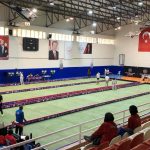Air sports, also known as aerial sports, are competitive or recreational activities that involve flying or operating in the air. These sports often require specialized equipment, training, and a high level of skill.
Air Sports are made up of the following:
Contents
- Skydiving:
- Involves jumping from an aircraft and free-falling before deploying a parachute. Variations include formation skydiving, freeflying, and wingsuit flying.
- Paragliding:
- A recreational and competitive sport where participants fly using a lightweight, free-flying glider. It often involves launching from hills or mountains.
- Hang Gliding:
- Similar to paragliding but uses a heavier, rigid-wing glider. Pilots launch from elevated areas and soar through the air.
- Hot Air Ballooning:
- A recreational activity where participants fly in a balloon powered by heated air. It is often enjoyed for its scenic and leisurely nature.
- Gliding (Sailplane Flying):
- Involves flying unpowered aircraft (gliders) that use natural air currents to stay aloft. It is a competitive sport with events like cross-country racing.
- Aerobatics:
- The practice of performing acrobatic maneuvers in aircraft, often seen in airshows and competitions. It includes disciplines like solo aerobatics and formation flying.
- Wingsuit Flying:
- A specialized form of skydiving where participants wear a wingsuit to glide through the air before deploying a parachute.
- Paramotoring:
- Combines paragliding with a motorized harness, allowing pilots to take off from flat ground and fly for extended periods.
- BASE Jumping:
- Involves jumping from fixed objects (Buildings, Antennas, Spans, and Earth) and using a parachute to land. It is considered an extreme sport due to its high risk.
- Drone Racing:
- A modern air sport where participants race small, agile drones through obstacle courses, often using first-person view (FPV) goggles.
- Air Racing:
- Involves aircraft racing around a set course, often at high speeds. Events like the Red Bull Air Race are popular.
- Kite Flying and Kiteboarding:
- While kiteboarding involves water, traditional kite flying is an air sport that includes competitive events like kite fighting and precision flying.
Reasons for Popularity in the Global Sports Market:
- Thrill and Adventure:
- Air sports offer an unparalleled adrenaline rush, appealing to thrill-seekers and adventure enthusiasts. The sensation of flying and defying gravity is a major draw.
- Unique and Spectacular:
- The visual spectacle of air sports, such as skydiving formations, aerobatic maneuvers, and wingsuit flights, captivates audiences and participants alike.
- Technological Innovation:
- Advances in equipment, such as lightweight materials, advanced parachutes, and high-performance gliders, have made air sports more accessible and safer.
- Media and Entertainment:
- Air sports are widely featured in documentaries, movies, and social media, increasing their visibility. Events like airshows and drone racing competitions attract large audiences.
- Community and Camaraderie:
- Air sports foster a strong sense of community, with clubs, training schools, and online forums bringing together enthusiasts. The shared passion for flying creates a tight-knit community.
- Accessibility and Inclusivity:
- While some air sports require significant training and investment, others, like paragliding and hot air ballooning, are more accessible to beginners. Adaptive programs also make air sports inclusive for people with disabilities.
- Competitive and Recreational Balance:
- Air sports offer both competitive and recreational opportunities, catering to casual participants and elite athletes alike.
- Tourism and Travel:
- Air sports destinations, such as skydiving centers, paragliding sites, and airshow locations, attract tourists from around the world, boosting local economies.
- Youth Appeal:
- Modern air sports like drone racing and wingsuit flying resonate strongly with younger audiences due to their high-tech and adrenaline-pumping nature.
- Cultural and Historical Significance:
- Many air sports, such as gliding and aerobatics, have deep historical roots and cultural significance, adding to their appeal.
- Economic Impact:
- The air sports industry generates significant revenue through equipment sales, training programs, event hosting, and tourism. Major events like the Red Bull Air Race attract sponsorships and media coverage.
- Inspiration and Role Models:
- Air sports athletes, such as skydivers, aerobatic pilots, and wingsuit flyers, serve as role models, inspiring others to take up these sports.
Economic Impact and Market Growth:
- Equipment Sales: The market for air sports equipment, such as parachutes, gliders, drones, and wingsuits, is worth billions of dollars.
- Training and Certification: Flight schools, skydiving centers, and training programs generate revenue through courses and certifications.
- Event Hosting: Major air sports events, such as airshows, drone racing competitions, and skydiving championships, attract participants and spectators, boosting local economies.
- Tourism: Air sports destinations benefit from international travelers, who spend on accommodations, dining, and activities.
Let’s Go AIR SPORTS!!!:
Air sports are a dynamic and growing segment of the global sports market, driven by their thrill, visual appeal, and technological innovation. Their ability to combine adventure with skill, along with strong community support and media exposure, ensures their continued popularity. As interest in unique and adrenaline-pumping activities grows, air sports are likely to remain a key player in the global sports landscape.















